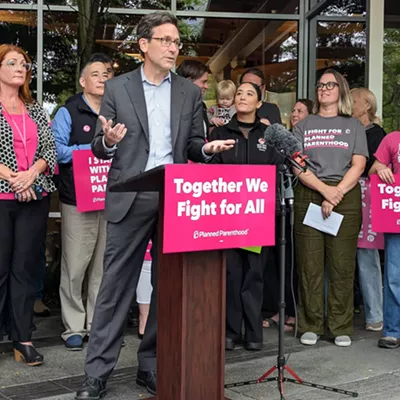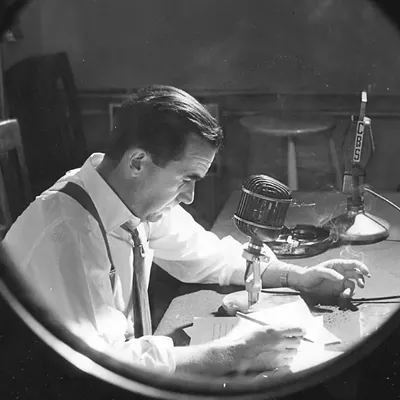Come in. Come in. Let's talk Ute.
Five times a day, five days a week, 90 Southern Ute Academy students -- from toddlers to nine-year-olds -- spend between half an hour and 45 minutes answering McKinley's questions about the weather, responding to their Ute names, learning the names for their eyes, hands and feet and singing songs.
McKinley's quiet Ute greetings belie a sense of urgency on Western tribal lands. Most linguists estimate there were 300 languages in North America before European settlement. That number shrank faster than you can say Manifest Destiny. Now, there are just 150 of those languages left -- and most of those are hanging on by a thread.
Mission and government schools, especially government boarding schools, hurried the decline. From the late-1800s into the 1970s, the Bureau of Indian Affairs pursued a nearly uninterrupted policy of severe assimilation for young tribal members.
McKinley, one of about 100 fluent Ute speakers on the Southern Ute Reservation in Colorado, grew up, as did most Indians during those years, in a boarding school where teachers often punished students for speaking their native language.
When they returned home after years away from the reservation, many had only a vague memory of their language and culture and were ashamed to admit to the little knowledge they had.
McKinley, in her late 50s, has a small group of friends who also speak Ute, but sometimes she has to keep in practice by speaking Ute to her cats. Most of the parents of her students at the Academy, the nation's only tribally funded Montessori school, spoke only English at home, hoping to save their own children from the kind of ridicule they had experienced in their youth. Now, they know only a smattering of Ute words, and the children themselves may never have heard the language until they entered McKinley's classroom.
Many tribes are feeling the same urgency McKinley feels. "There are two intersecting lines," says Darrell Kipp, the director of the Piegan Institute on the Blackfeet Reservation in Montana. "One is the number of years our fluent speakers have left, and the other is the amount of time it takes to produce new speakers. When those lines no longer intersect, we'll have lost our language -- forever."
Though grammars and dictionaries have been developed by tribal elders and linguists, there are even fewer writers than speakers. It's very difficult to protect vocabulary that's infrequently used.
Says Dick Littlebear, president of Chief Dull Knife College on the Northern Cheyenne Reservation in Montana, "I remember my grandfather saying, 'This is what you call a horse, this is what you call a cart, this is what you call feed,' " he says. "Of course, when you're young, you don't pay attention. Now I wish I had."
"THE HOUSE IS AFIRE"
Some tribes have been able to resist the fatal spiral. The Crow Tribe in southeastern Montana, which has a reputation for insularity, has about 9,800 enrolled members and, according to the 1990 Census, about 4,200 Crow speakers. The nation's largest tribe, the Navajo, counts nearly 150,000 speakers out of about 220,000 members.
But many tribes number their native speakers in the tens or single digits. Some count only one speaker -- people in their 80s or 90s or beyond, who have, literally, no one left to talk to.
Only a few people off the reservation recognized that tribal languages were hemorrhaging words. One was California linguist J.P. Harrington. From the early-1900s until his retirement in 1954, Harrington studied more than 90 tribal languages throughout the Americas. Today, his notes and recordings are the only clues to several extinct languages.
"The time will come," Harrington wrote in 1941, when "all the languages developed for thousands of years will be ashes; the house is afire, it is burning."
During World War II, 29 Navajo soldiers known as the Code Talkers sounded the alarm when they developed an uncrackable code for the armed forces based on their unique native language. It proved to be invaluable for communiques that needed to be impenetrable to enemy decoders. Thanks in part to recognition for the Code Talkers and in part to the civil rights movement, the Bureau of Indian Affairs' policy against tribal languages in schools began to soften in the late-1960s.
Tribal languages received their biggest official boost in 1990, when the Native Languages Act vowed to "preserve, protect and promote" the right of tribal members to speak and teach tribal languages. Later, an amendment provided some funding for language-education programs through the federal Administration for Native Americans.
These policy changes mirrored an expanding language-rescue operation on reservations. "There's an enormous amount of energy around this issue," says Ruth Yellow Hawk of the Indigenous Issues Forums in Rapid City, S.D. At the National Indian Education Association annual conference in Montana this fall, she says, "People were saying, 'We're racing against time. We have to find willing elders to teach us.' "
But it's not easy. Many elders were separated from their families at a young age, their knowledge of the tribal language isn't perfect and their own memories of classrooms may be unpleasant, at best. "Now we're asking them to go into a classroom and explain the language to an English-speaking child," says Joyce Silverthorne, who oversees the Salish and Kootenai language-instruction programs in seven public high schools in Montana.
Nonetheless, many elders have been enormously active in language revitalization projects, teaching with special certification as language specialists.
IMMERSION NECESSARY
While tribal language programs are exposing a new generation to these vulnerable languages, they're not yet creating the real life preserver: young, fluent speakers. Georgia McKinley, the Southern Ute language instructor, says her brief classes alone won't protect her language from extinction. "I just hope," she says, "that they somehow use it as they grow older." Fluency, she believes, will not become a reality.
On the Blackfeet Reservation in northwestern Montana, Darrell Kipp is determined to make young, fluent Blackfeet speakers a reality. He's been working at it for 15 years.
Kipp grew up speaking Blackfeet at home with his parents and grandparents. After graduating from high school, he left the reservation in the 1960s to attend Montana State University in Bozeman, serve a tour of duty in Vietnam and earn master's degrees from Goddard College and Harvard University.
In the early-1980s, when Kipp and a small group of Blackfeet friends returned to the reservation hoping to relearn their language, they found that the number of fluent speakers had dropped dramatically. "We met people who could not only not speak the language, but also had a negative view of the language," he says.
But Kipp and his friends persisted, and in 1987 founded the Piegan Institute, a nonprofit dedicated to restoring, protecting and preserving Native American languages.
The Blackfeet activists discovered that the only programs producing new speakers were immersion schools, where students spoke the language all day, every day. They modeled the institute after the Akwesasne Freedom School, in upstate New York, founded by Mohawk parents in 1979, where immersion in the language proved to be the key to success. With the help of two elders, the Piegan Institute immersed six young teachers in the Blackfeet language. The experiment worked, and with Blackfeet-speaking teachers on hand, the Piegan Institute opened the Nizi Puh Wah Sin, or Real Speak School, in 1994.
REAL VALIDATION
Today, the Real Speak school has 36 students, from kindergartners to eighth-graders, and its first graduate, who is fluent in English and Blackfeet, now attends a public high school on the reservation. But, notes Kipp, "It took 500 years and enormous expense to almost get rid of these languages. They aren't going to recover in one year or two years. What we need is a full-fledged, multi-year process to reinvigorate the language."
While the Blackfeet program and its counterparts are reinvigorating a very particular kind of biodiversity, the rich diversity of language, the program is also on a much larger mission: social and cultural restoration.
"It's a very deep rejuvenation of the community," Kipp says. "When our children go into the community and speak the language, people are overwhelmed. They say, 'That's too much! I want one of those kids!' "
Children who are comfortable with their own language and culture, he says, are comfortable with themselves. That means fewer dropouts, fewer attendance and discipline problems, and many more successful students. In Indian country, where the youth suicide rate is nearly three times the national average, such programs can be literal lifesavers.
But tribal-language education still faces hostility off the reservation. Joyce Silverthorne was horrified when the Montana Legislature passed a bill in 1995 making English the "official and primary" language of the state. Though the law hasn't directly affected her programs, she fears it and other states' legislative agendas could open the door to future restrictions.
Among tribes today, says Silverthorne, "There's a passionate recognition that language is being lost." And, she says, a recognition of what that means: "Young people understand that loss of language is going to change the people we are."
This article first appeared in High Country News (www.hcn.org), which covers the West from Paonia, Colo.














